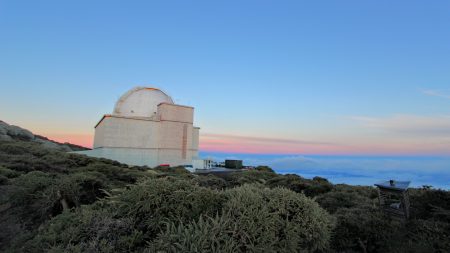The Cubic Kilometre Neutrino Telescope (KM3NeT), a groundbreaking scientific endeavor, is taking shape in the depths of the Mediterranean Sea. Unlike traditional telescopes that capture light, KM3NeT is designed to detect neutrinos, elusive subatomic particles emanating from the cosmos’s most enigmatic corners. The sheer rarity and stealthy nature of high-energy neutrinos necessitate the construction of a detector of immense proportions, hence the transformation of a cubic kilometer of the Mediterranean into a sprawling neutrino observatory. This ambitious project involves two separate telescopes, each comprised of an array of spherical, pressure-resistant glass detectors strung along vertical cables, resembling giant pearl necklaces submerged hundreds of meters below the surface. These “pearls,” each housing an array of photomultiplier tubes, are poised to capture the faint light signatures generated when neutrinos interact with seawater. This underwater forest of detectors, situated off the coasts of Sicily and Southern France, represents a novel approach to exploring the universe’s hidden secrets.
Deploying these complex instruments in the deep sea presents a unique set of challenges. Annual month-long expeditions see physicists, unaccustomed to the rolling waves, embarking on arduous voyages to meticulously position the detector strings. Time is of the essence, with each hour at sea carrying a significant financial burden. Despite potential seasickness and fatigue from irregular sleep patterns, the scientists must maintain unwavering focus and make critical decisions on the fly should any complications arise, whether due to equipment malfunctions or unpredictable weather. The deployment process is a marvel of precision engineering. Each detector string, coiled within a large launching structure, is gradually lowered to the seabed by a ship-mounted crane. A remotely operated submersible vehicle then dives to the ocean floor to connect the string to the network and conduct thorough inspections. A simple pull of a handle by the submersible initiates the unfurling of the string, which is buoyed upwards. As the strand rises, the spherical detectors are released, akin to a fern frond unravelling its delicate leaves.
The rigorous deployment process necessitates meticulous preparation and flawless execution. Every component must be in perfect working order before it descends into the abyss, as there’s no opportunity for adjustments or repairs once the detector string is integrated into the underwater network. This echoes the challenges associated with sending scientific instruments to the moon, where pre-launch checks are paramount to mission success. Back on land, a dedicated team monitors the performance of the newly deployed strings, addressing any issues in real time. This comprehensive approach ensures the seamless functioning of the telescope’s intricate network, maximizing its potential for scientific discovery.
The two telescopes that make up KM3NeT serve distinct, yet complementary purposes. The Sicilian telescope focuses on detecting high-energy neutrinos originating from distant cosmic sources, providing insights into the universe’s most powerful phenomena. The French telescope, on the other hand, is designed to study atmospheric neutrinos, aiming to unravel the mysteries of neutrino oscillations – the process by which neutrinos transform from one type to another. This dual approach, combining cosmic and atmospheric neutrino observations, promises to significantly advance our understanding of these fundamental particles. The underlying principle behind KM3NeT bears resemblance to the IceCube Neutrino Observatory located at the South Pole, which also detects neutrinos through the faint light they produce. However, IceCube captures these flashes within glacial ice, highlighting the innovative use of different media for neutrino detection.
KM3NeT, while still under construction, is already yielding valuable scientific results. Researchers are utilizing the partially completed telescopes to probe fundamental physics questions, such as the effects of quantum gravity on neutrinos and refining measurements of neutrino oscillations. These early findings demonstrate the telescope’s potential to make significant contributions to our understanding of the universe’s fundamental laws. The project’s scientific scope extends beyond astrophysics, encompassing particle physics and cosmology.
The pursuit of scientific knowledge often leads researchers to unconventional environments. KM3NeT’s underwater location is a testament to this spirit of exploration, pushing the boundaries of astronomical observation. Physicists have ventured to extreme locations like the South Pole and deep underground mines in their quest to unravel the universe’s mysteries. Compared to these harsher environments, the Mediterranean Sea, with its breathtaking sunsets and picturesque beaches, offers a relatively pleasant setting for scientific discovery. The unique combination of challenging scientific work and a scenic backdrop makes KM3NeT a compelling case for the pursuit of knowledge in unexpected places. The project exemplifies the ingenuity and adaptability of physicists, who continually devise innovative solutions to address complex scientific questions, venturing to the ends of the earth – and beneath its waves – in their tireless pursuit of understanding.















